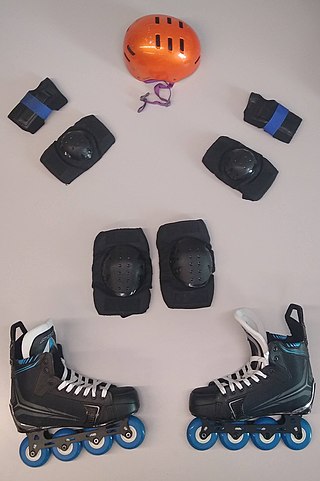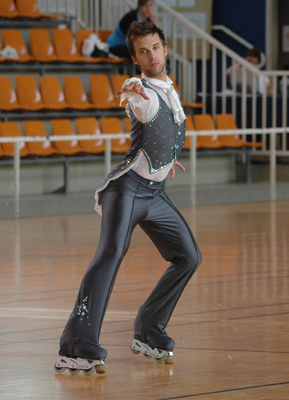Roller hockey is a form of hockey played on a dry surface using wheeled skates. It can be played with traditional roller skates or with inline skates and use either a ball or puck. Combined, roller hockey is played in nearly 60 countries worldwide.

Winter sports or winter activities are competitive sports or non-competitive recreational activities which are played on snow or ice. Most are variations of skiing, ice skating and sledding. Traditionally, such games were only played in cold areas during winter, but artificial snow and artificial ice allow more flexibility. Playing areas and fields consist of either snow or ice.

Ice skates are metal blades attached underfoot and used to propel the bearer across a sheet of ice while ice skating.

Inline skates are a type of roller skate used for inline skating. Unlike typical roller skates, which have two front and two rear wheels, inline skates typically have two to five wheels arranged in a single line. Some, especially those for recreation, have a rubber "stop" or "brake" block attached to the rear of one or occasionally both of the skates so that the skater can slow down or stop by leaning back on the foot with the brake skate.

Roller skating is the act of travelling on surfaces with roller skates. It is a recreational activity, a sport, and a form of transportation. Roller rinks and skate parks are built for roller skating, though it also takes place on streets, sidewalks, and bike paths.

Inline speed skating is the roller sport of racing on inline skates. The sport may also be called inline racing, or speed skating by participants. Although it primarily evolved from racing on traditional roller skates, the sport is similar enough to ice speed skating that many competitors are known to switch between inline and ice speed skating according to the season.
Skating involves any sports or recreational activity which consists of traveling on surfaces or on ice using skates, and may refer to:
The Fédération Internationale de Roller Sports was the world governing body for roller sports, including skateboarding, rink hockey, inline hockey, inline speed skating, inline alpine, downhill, roller derby, roller freestyle, inline freestyle, aggressive inline skating, inline figure skating and artistic roller skating. It was established in April 1924 in Montreux, Switzerland by two Swiss sportsmen, Fred Renkewitz and Otto Myer, who had close connections to the International Olympic Committee.
USA Roller Sports (USARS), formerly the United States Amateur Confederation of Roller Skating, is the national governing body of competitive roller sports in the United States. It is recognized by the International Roller Sports Federation (FIRS) and the United States Olympic Committee.

Roller skates are shoes or bindings that fit onto shoes that are worn to enable the wearer to roll along on wheels. The first roller skate was an inline skate design, effectively an ice skate with wheels replacing the blade. Later the "quad skate" style became more popular, consisting of four wheels arranged in the same configuration as a typical car.

Roller in-line hockey, American roller hockey or inline hockey, is a variant of hockey played on a hard, smooth surface, with players using inline skates to move and ice hockey sticks to shoot a hard, plastic puck into their opponent's goal to score points. The sport is a very fast-paced and free-flowing game and is considered a contact sport, but body checking is prohibited. There are five players including the goalkeeper from each team on the rink at a time, while teams normally consist of 16 players. There are professional leagues, one of which is the National Roller Hockey League (NRHL). While it is not a contact sport, there are exceptions, i.e. the NRHL involves fighting.

Artistic roller skating is a competitive sport similar to figure skating but where competitors wear roller skates instead of ice skates. Within artistic roller skating, there are several disciplines:

Heelys is an American brand of roller shoe that have usually one or more removable wheels embedded in each sole, similar to inline skates, allowing the wearer to walk, run, or, by shifting their weight to their heels, roll. Braking can be achieved by lowering the back of the foot so that sole contacts the ground. Roger Adams patented Heelys in 1999. The headquarters are located in Carrollton, Texas.
Roller sports are sports that use human powered vehicles which use rolling either by gravity or various pushing techniques. Typically ball bearings and polyurethane wheels are used for momentum and traction respectively, and attached to devices or vehicles that the roller puts his weight on. The international governing body is World Skate.

The European Confederation of Roller Skating, currently branded as World Skate Europe, is a governing body of roller skating and inline skating in Europe. The World Skate Europe is a member of World Skate, formerly the International Roller Sports Federation (FIRS).

Aggressive inline skating is a sub-discipline of inline skating in the action sports canon. Aggressive inline skates are specially modified to accommodate grinds and jumps. Aggressive skating can take place on found street obstacles or at skate parks.

Vert skating or vertical skating is a discipline using skates like inline skates or roller skates on a vert ramp, a style of half-pipe. In vert skating, the skater is able to achieve more air-time as compared to other styles of skating, meaning skaters can perform complicated aerial maneuvers and acrobatic tricks, such as spins and flips.
The World Skate Games are an international biennial multi-sport event, comprising all the world roller sport disciplines as regulated by the World Skate international federation. The games involve 11 World Championships in one multi-sport event.

World Skate is the only governing body in the world for all sports performed on skating wheels. The organisation is the successor of the Fédération Internationale de Roller Sports (FIRS) founded on 21 April 1924.















